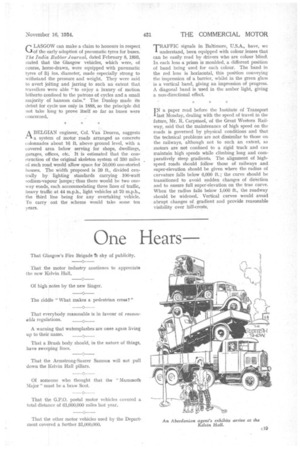Passing Comments
Page 84

Page 85

If you've noticed an error in this article please click here to report it so we can fix it.
APPARENTLY every possible means for the detection of " crime" is to be used against the poor
motorist, for in a recent case at the Doncaster West Riding Court, where a deputy police surgeon was charged with driving carelessly, the police stated that they were in a position, if required, to produce as evidence a cinematograph film of the occurrence. The entertainment proposed was not actually required, as the defendant was fined without further proof, although he did not appear particularly displeased as he shook hands with the officers.
THE fact that the streets of London are almost wholly free from the smell of burnt oil fuel constitutes a tribute both to the Associated Equipment Co., Ltd., and to the maintenance engineers of the London Passenger Transport Board. Oil-engined vehicles of lower efficiency or less ably maintained running in such numbers would almost certainly create an obnoxious atmosphere, as is evidenced by the less carefully treated vehicles, with power units of similar type, one from time to time encounters on the road, in London and elsewhere. GLASGOW can make a claim to honours in respect of the early adoption of pneumatic tyres for buses. The India Rubber Journal, dated February 8, 1893, stated that the Glasgow vehicles, which were, of course, horse-drawn, were equipped with pneumatic tyres of 3i ins, diameter, made especially strong to withstand the pressure and weight. They were said to avert jolting and jarring to such an extent that travellers were able "to enjoy a luxury of motion hitherto confined to the patrons of cycles and a small majority of hansom cabs." The Dunlop made its debut for cycle use only in 1888, so the principle did not take long to prove itself so far as buses were concerned.
A BELGIAN engineer, Col. Van Deuren, suggests
a system of motor roads arranged as concrete colonnades about 16 ft. above ground level, with a covered area below serving for shops, dwellings, garages, offices, etc. It is estimated that the construction of the original skeleton system of 530 miles of such road would allow space for 50,000 one-storied houses. The width proposed is 59 ft., divided centrally by lighting standards carrying 100-watt sodium-vapour lamps ; thus there would be two oneway Toads, each accommodating three lines of traffic, heavy traffic at 44 m.p.h., light vehicles at 70 m.p.h., the third line being for any overtaking vehicle. To carry out the scheme would take some ten years.
TRAFFIC signals in Baltimore, U.S.A., have, we understand, been equipped with colour lenses that can be easily read by drivers who are colour blind. In each lens a prism is moulded, a different position of band being used for each colour. The band in the red lens is horizontal, this position conveying the impression of a barrier, whilst in the green glass is a vertical band, giving an impression of progress. A diagonal band is used in the amber light, giving a non-directional effect.
IN a paper read before the Institute of Transport
last Monday, dealing with the speed of travel in the future, Mr. R. Carpmael, of the Great Western Railway, said that the maintenance of high speed on the roads is governed by physical conditions and that the technical problems are not dissimilar to those on the railways, although not to such an extent, as motors are not confined to a rigid track and can maintain high speeds while climbing long and cornpaxatively steep gradients. The alignment of highspeed roads should follow those of railways and super-elevation should be given where the radius of curvature falls below 6,000 ft.; the curve should be transitioned to avoid sudden changes of direction and to ensure full super-elevation on the true curve. When the radius falls below 1,000 ft., the roadway should be widened. Vertical curves would avoid abrupt changes of gradient and provide reasonable visibility over hill-crests.




















































































































































































